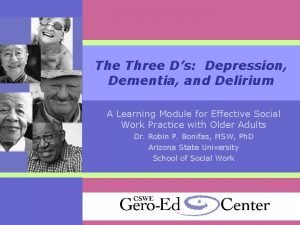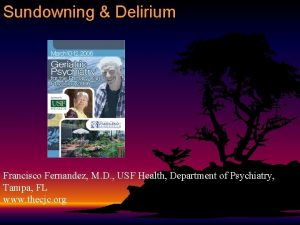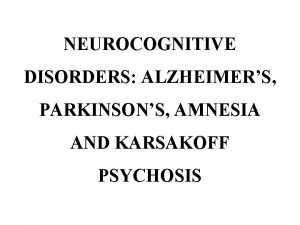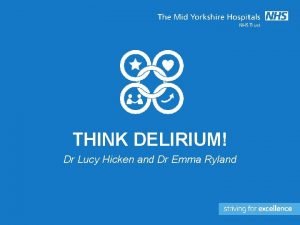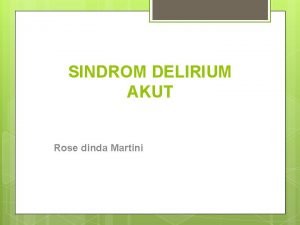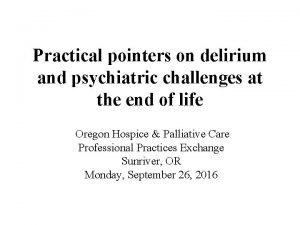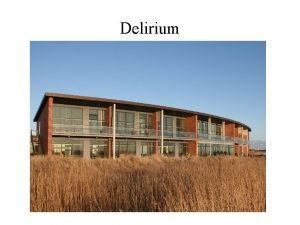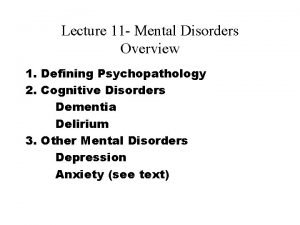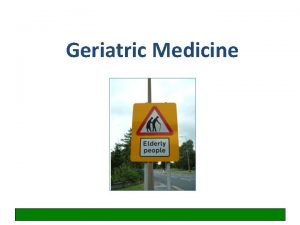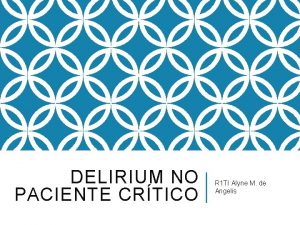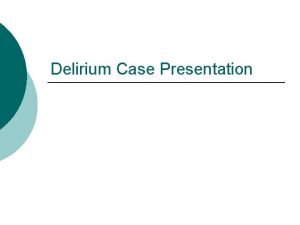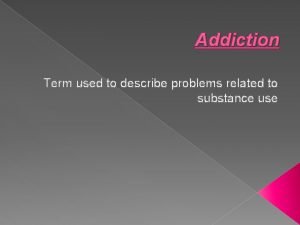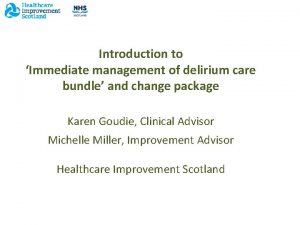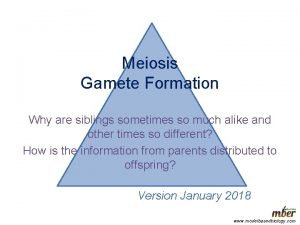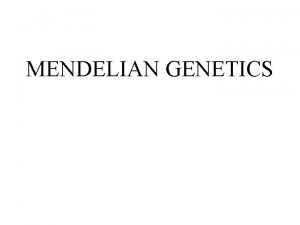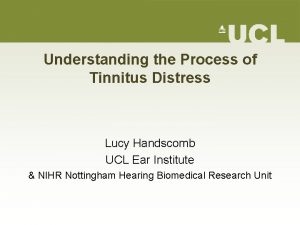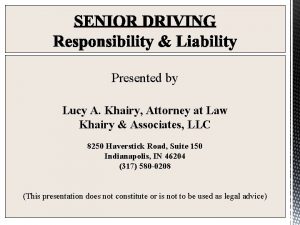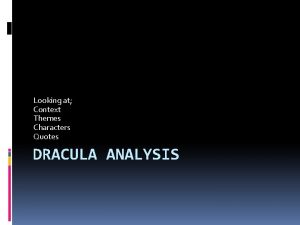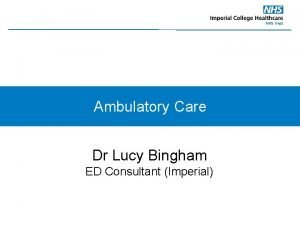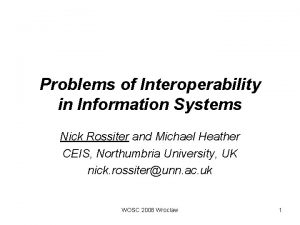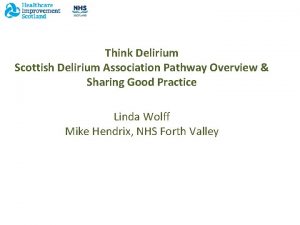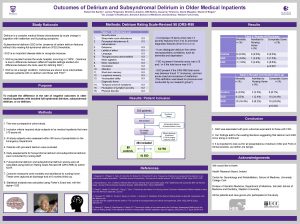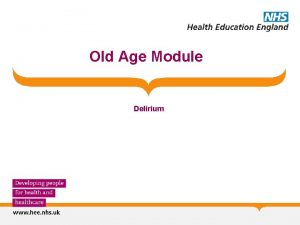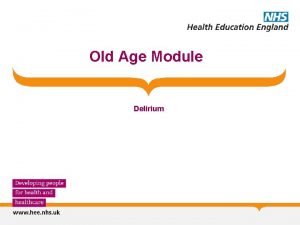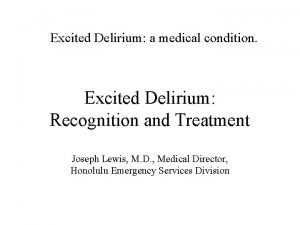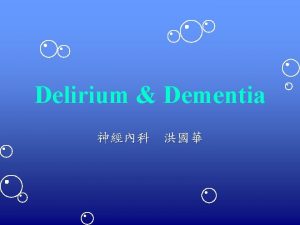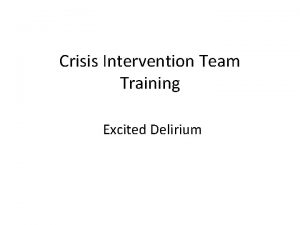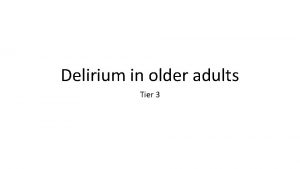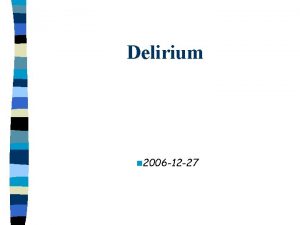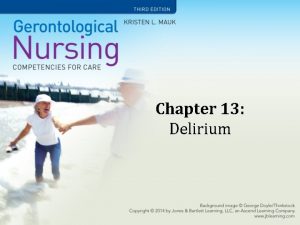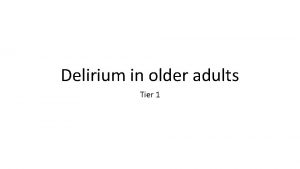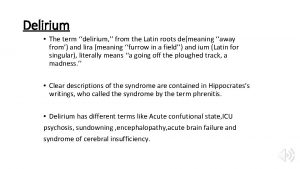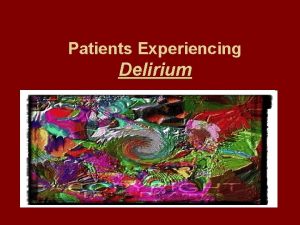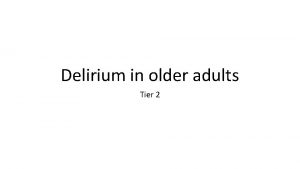THINK DELIRIUM Dr Lucy Hicken and Dr Emma

















![Recognising Delirium • SQi. D: • ‘Do you think [patient] has been more confused Recognising Delirium • SQi. D: • ‘Do you think [patient] has been more confused](https://slidetodoc.com/presentation_image_h/22c30bf99272444a0ec5ff8d12791c92/image-18.jpg)
























- Slides: 42

THINK DELIRIUM! Dr Lucy Hicken and Dr Emma Ryland

Aims • • To inform you about delirium To help you DETECT delirium To help you MANAGE delirium To help you PREVENT delirium

What is Delirium? • https: //vimeo. com/31892402? lite=1 • up to 04. 23

What is Delirium? • • A disturbance of consciousness and a change in cognition Reduced ability to focus, sustain or shift attention Short period of time – acute Tendency to fluctuate • • • Hypoactive form – withdrawn, sleepy, not interacting Hyperactive – restless, agitated, hyperactive Mixed Sleep disturbance Emotional disturbance - FEAR • ‘They seem more confused than usual today doctor’

Isn’t delirium like dementia? Feature Delirium Dementia Depression Onset Sudden Insidious Gradual Fluctuations Yes – over hrs Not usually Situational Duration Hours – 1 month Months - years Weeks - years Cause Acute illness reversible Chronic degeneration Reactive / biochemical Normal Conscious level Abnormal Memory Impaired May refuse to answer Conversation Often slow, inappropriate Word finding difficulties Sparse Orientation Varies Impaired Normal Hallucinations Often present Rarely present Night-time Worse Can be worse No effect

Delirium – why it’s important • • COMMON!! – affects around 10% of all hospitalised patients 40% of elderly inpatients 80% ICU admissions Poorly recognised – 50% cases go undetected • Delirium is a MEDICAL EMERGENCY! • • Doubled in-hospital mortality rate in >65 s Increased rate of hospital acquired infection Increased length of stay Increased risk of admission to institutional care • Can last up to 6 months

Why do we need Delirium Guidelines? • Evidence that we can prevent delirium in at least one third of high risk patients • Evidence that effective management reduces the severity and length of an episode of delirium and therefore reduces distress for patient, family, staff and reduces length of stay

Why do we need Delirium Guidelines? • NICE guidance on delirium issued July 2010 – Assess all new patients for risk of delirium – Within 24 hours of admission initiate an individualised prevention intervention for those at risk of delirium – Identify and diagnose delirium at admission – Follow management guidelines including effective communication, reorientation and nonpharmacological management of distress

Preventing Delirium

Risk factors for developing delirium • • • Age Pre-existing cognitive impairment Previous episode of delirium Current hip fracture Current severe physical illness Sensory impairment: hearing or visual Tick Please complete Delirium Care Pathway for patient with ANY ONE OF: Age 65 years or older Dementia or AMT score <8/10 Current hip fracture Severe illness (a clinical condition that is deteriorating or is at risk of deterioration) Delirium present

Interaction of Risk Factors and Precipitants • More risk factors = more vulnerable • Possess more risk factors • Only need minor precipitant to initiate episode of delirium

Prevent delirium by managing delirium risk factors Unchangeable risk factors Manageable risk factors Older age Drugs /medications Dementia Dehydration Pre-hospital fracture Pain Disorientation Reduced mobility Constipation Visual & hearing impairment

Prevent delirium by improving sensory environment • • Spectacles – available and clean Hearing aids – available and working Cognitive stimulation talk to patients Regular reorientation several times a day Tell patients clearly what is happening and why before you touch them, speak slowly, use eye contact Encourage sleep – quiet as possible, no medications at night, mobilise during day Encourage family to bring in familiar objects and visit Avoid bed / ward moves }

Prevent Delirium by using Delirium Care Pathway • Available now! • Start using it NOW! • On Intranet: Departments – Elderly Medicine – Delirium • This talk is your training

Daily Care Plan

Daily Care Plan page 2

Diagnosing Delirium • THINK DELIRIUM!
![Recognising Delirium SQi D Do you think patient has been more confused Recognising Delirium • SQi. D: • ‘Do you think [patient] has been more confused](https://slidetodoc.com/presentation_image_h/22c30bf99272444a0ec5ff8d12791c92/image-18.jpg)
Recognising Delirium • SQi. D: • ‘Do you think [patient] has been more confused lately? ’ put to friend or family member • Perform or ask ward doctor formal diagnosis of delirium using CAM • Complete Delirium Care Pathway • SQi. D = single question in delirium

Recognising Delirium • Perform AMTS on all new admissions >64 years of age and all positive SQi. D • If score <8/10 consider delirium or dementia • If patient “confused” “vague” “agitated” “poor historian” assume it is new = THINK DELIRIUM! • To confirm whether this is delirium: • Speak to family/carers about usual cognitive state – USE THE TELEPHONE! • Monitor cognitive state & behaviour to identify a change – SPEAK TO THE PATIENT!

Diagnosing Delirium • https: //www. youtube. com/watch? v=M 4 ws PTt. Ge. Ic • https: //www. youtube. com/watch? v=9 QUR zexh. WP 4 to 30 secs

CAM Confusion Assessment Method • CAM most common delirium diagnosis tool • Sensitivity 94 -100% Specificity 90 -95% High inter-rater reliability THINK DELIRIUM! Screen all patients aged 65 or over, or <65 with history of cognitive impairment, using the Confusion Assessment Method (CAM) tool below: Feature 1: Acute onset of mental status change and/or fluctuating course (e. g. more confused than usual) Feature 2: Inattention (difficulty concentrating, easily distracted) Feature 3: Disorganised thinking (rambling speech, odd flow of ideas) OR Feature 4: Altered level of consciousness 1 + 2 + (3 AND/OR 4) = Delirium screen positive? No Yes If Yes, complete Delirium Care Pathway

Frequently Asked Questions • How recent is recent? Within the last month, but usually more recent than that. • How do I detect fluctuation? Changes in confusion (presence/absence or severity of symptoms) over the past 24 hours have been detected by yourself or family. Or a different state to the one you are observing has been documented by colleagues within the past 24 hours.

Frequently Asked Questions • What is inattention? Examples: - Questions must be frequently repeated because attention wanders, NOT because of decreased hearing. - Unable to gain patient’s attention or to make any prolonged eye contact. - Patient’s focus seems to be darting about room. - Patient keeps repeating answer to previous question (perseveration). - Patient is dazedly staring. When you ask a question, he looks at you momentarily but does not answer. He then continues to stare.

Frequently Asked Questions • What is disorganised thinking? Rambling or irrelevant conversation – not related to the question you asked them. Illogical flow of ideas and unpredictable switching from subject to subject during their conversation. Incoherent speech – you are unable to make any sense of what they are saying, and they do not have a known speech disorder N. B. Patient must be able to speak or write (e. g. , not comatose) to assess this item. If they are unconscious, score them as 0. This is NOT just disorientation to time/person/place.

Frequently Asked Questions • What is hypervigilance? This is a form of abnormal conscious level, the opposite to drowsiness. The patient startles easily to any sound or touch. Their eyes are wide open.

Delirium Associated Features • Sleep-wake cycle disturbance • Psychomotor disturbance Hypoactive Hyperactive • Emotional disturbance - FEAR • EEG abnormalities

Diagnosing Delirium – What Next? • Record diagnosis in medical notes • Inform colleagues • Commence Delirium Care Pathway • Inform patient and family (leaflet) • Investigate - Treat - Reassure

Investigating Delirium

Why is it important to identify delirium? • DELIRIUM IS A MEDICAL EMERGENCY! • IF delirium identified early & all causes treated, it frequently resolves, patients have better outcomes

Identifying Underlying Causes of Delirium • Delirium is due to an underlying general medical condition but this is not always immediately apparent • Usually more than one cause of delirium in older patients • Risk factors become additional causes once delirium present – need to manage the risk factors as well

Causes of Delirium • • • PINCH’S ME P pain I infection N nutrition C constipation H hydration (+urine retention) S sleep M medication E electrolytes

Identifying underlying causes of delirium • Perform basic observations • Perform basic assessments (for urine retention, constipation, pain, distress) • History and examination (inc. neurological) • Basic investigations: ECG / Blood glucose / MSU / FBC / CRP / Blood cultures / U&E / Calcium / CXR • Medication review

Managing Delirium

Daily Care Plan • Use same care plan to treat as for preventing delirium • On Intranet: Departments – Elderly Medicine – Delirium

Daily Care Plan

Daily Care Plan page 2

Managing Delirium without Medications • • Communicate sensitively - make eye contact - respect personal space - explain who you are and what you are about to do before you touch them • - speak slowly and clearly using simple language • - acknowledge the feelings expressed – ignore the content, change the subject • Encourage mobility and hydration • Avoid restraint

Managing agitated delirium • Non-pharmacological management of agitation – nurse near nurses station OR side room – bed moves are avoided unless absolutely necessary – ask family to come in – ensure lighting adequate and area quiet – allow to wander under supervision • • Consider short-term (≤ 1 week) use of haloperidol or Olanzapine to reduce severity of delirium DON’T use to manage behaviour that challenges • Haloperidol (0. 5 mg PO/IM usually bd, with maximum dosing frequency every 30 minutes and maximum dose in 24 hours 2 mg) • ECG should be checked for QTc immediately prior to and at least once during use as prolongation of QTc is a relative contraindication to use of Haloperidol. • Olanzapine 2. 5 or 5 mg (PO orodispersible Velotab once daily maximum) as a last resort. • Lorazepam 0. 5 mg PO /IM (if available)/sublingual where antipsychotics contraindicated - e. g. Lewy body dementia, Parkinson's disease, prolonged QTc on ECG, bradycardia and phaeochromocytoma. Titrate doses cautiously according to symptoms.

Resolving delirium • • Monitor for improvement or deterioration Use serial AMTS / CAM Plus monitor features of delirium Continue Delirium care Pathway to prevent further episodes

Ongoing delirium • Re-investigate from beginning if deteriorating • Consider opinion from liaison psychiatry 51746 (esp. if uncertain of diagnosis)or Dementia and Delirium Support nurses – 51658, 51739 • At discharge: • Document episode of delirium on TTO/inform GP • Document any planned follow up from mental health team, memory clinic etc • If decision made to continue antipsychotic meds, clearly state why and follow up plan for this

THINK DELIRIUM!

Do’s and Don’ts in Delirium
 Mark hicken
Mark hicken Think big think fast think ahead
Think big think fast think ahead Difference between dementia and delirium
Difference between dementia and delirium Francisco fernandez md
Francisco fernandez md Difference between delirium and dementia table
Difference between delirium and dementia table Lucie big delirium
Lucie big delirium Dr rose dinda martini
Dr rose dinda martini Nash delirium
Nash delirium Terminalt delirium
Terminalt delirium Cam icu escala
Cam icu escala Delirium care pathways
Delirium care pathways Delirium definition
Delirium definition Delirium definition
Delirium definition Energy transfer theory
Energy transfer theory Escala rass
Escala rass Delirium case presentation
Delirium case presentation Flocculation delirium
Flocculation delirium Nilai gcs
Nilai gcs Driver diagram palliative care
Driver diagram palliative care A little bird by aileen fisher
A little bird by aileen fisher Think family ni
Think family ni Gamete formation
Gamete formation Lucy liu and my girl drew
Lucy liu and my girl drew Lucy and maria aylmer
Lucy and maria aylmer St lucy's home raised by wolves answers
St lucy's home raised by wolves answers Lucy calkins writing units
Lucy calkins writing units Lucy pepper
Lucy pepper Padesky and mooney 1990
Padesky and mooney 1990 Lucy pračovjek
Lucy pračovjek Lucy calkins quotes
Lucy calkins quotes Lucy khairy
Lucy khairy Never let me go chapter 11
Never let me go chapter 11 Lucy lambert hale
Lucy lambert hale Lucy westenra quotes
Lucy westenra quotes Lucy slinger ikea
Lucy slinger ikea Lucy langer md compass oncology
Lucy langer md compass oncology Lucy flesch
Lucy flesch Lucy bingham
Lucy bingham Lucy garratt
Lucy garratt Lucy slinger
Lucy slinger Lucy manfredi
Lucy manfredi Vital signs and anthropometric measurements:
Vital signs and anthropometric measurements: Lucy rossiter
Lucy rossiter


